Morris & Fan. Reservoir Sedimentation Handbook
Подождите немного. Документ загружается.

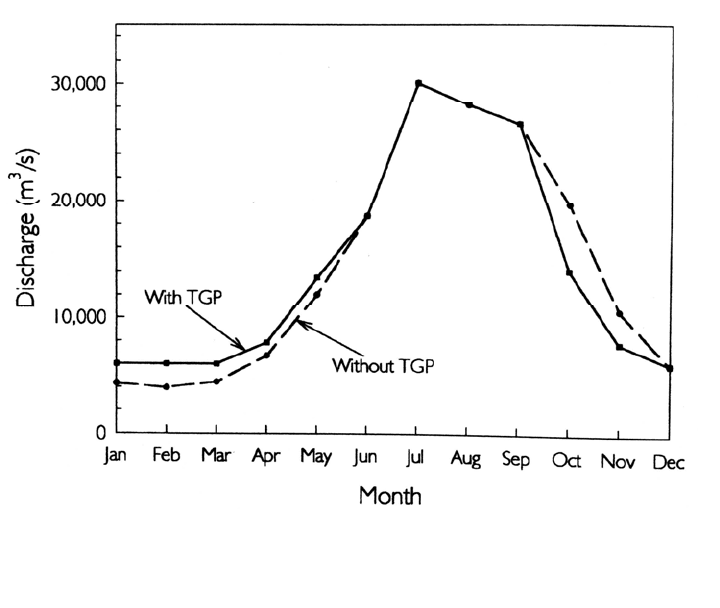
SEDIMENT ROUTING 13.6
FIGURE 13.4 Hydrograph of Yangtze River below Three Gorges Project, showing that the natural
hydrograph is largely preserved to route sediments through the impounded reach (redrawn from
Chen, 1994).
pat
ed to be small, on the order of 170,000 m
3
/yr. Significant deposition is anticipated in
the vicinity of the ship locks and the rate of deposition will increase over time, reaching
approximately 1 or 2 Mm
3
/yr when sediment equilibrium conditions are achieved. This
deposition will be removed by dredging. River training works are also anticipated in some
locations to facilitate navigation, especially in zones where the channel naturally switches
from one side of the river to the other in different seasons. River training works will also
be required to limit sediment deposition around shipping terminals in the port of
Chongqing at the upstream limit of the reservoir.
Despite decades of study and numerous numerical and physical modeling studies, there
still remain uncertainties. For instance, it is not possible to precisely predict the hydraulic
roughness when the reservoir is in operation, since the existing bed of gravel and bedrock
will be covered with sediment and the now-exposed walls of the gorge will become
submerged. An error of ± 10 percent in estimating the hydraulic roughness coefficient for
these new conditions will produce an error of + 2.1 m or -2.8 m in the stage along the
backwater reach for the flood having the 1 percent recurrence interval (Lin et al., 1993).
All projections also depend to some degree on the unpredictable sequence and magnitude
of floods following construction, and future sediment yield. As operation begins the
reservoir will be filled by increments, and the response of the river system will be
observed at each stage to detect potential problems and adjust operation accordingly.
13.2.4 Seasonal Emptying of Reservoir
When a reservoir is seasonally emptied for sediment routing the effect is similar to
flushing, since emptying will cause a channel to be eroded along the thalweg and sediment
will be eroded. Reservoir emptying may be classified as sediment routing when the low-

SEDIMENT ROUTING 13.7
level outlets remain open through essentially the entire flood season, so that most sediment
is released by routing rather than by erosion of previously deposited sediment. The
appropriate classification in some cases will be ambiguous.
An important advantage of seasonal emptying for sediment pass-through is that the
peak concentration of sediment released downstream can be smaller than if the reservoir is
operated for flushing. This can be critical from the aspect of environmental impact on the
downstream river system and other users. At a sensitive site, sediment routing may be
feasible whereas flushing is not. For this reason a distinction should be made between
routing and flushing operations, even when both involve reservoir emptying.
The case study of Sanmenxia Reservoir on China's Yellow River provides an example
of a large multipurpose seasonally empty reservoir operated with the primary objective of
sediment routing. The case study of Heisonglin irrigation reservoir combines elements of
both routing and flushing. Sediment accumulation is minimized by the short detention
period for each flood, and sediment deposited during the detention period is flushed during
free-flow periods between floods.
In some cases a community may be served by an unregulated stream diversion which
has inadequate capacity during the dry season, yet the water demand is not large enough to
justify a large conventional reservoir. In such a case a seasonal-use reservoir may also be
operated in conjunction with the unregulated stream diversion to augment the dry season
water supply. During the flood season, all deliveries are made from the stream diversion
while the reservoir remains empty for sediment routing. Near the end of the flood season,
the reservoir is refilled to provide a regulated water supply during the dry season. Because
sediment is routed through the small reservoir, it may be sized according to hydrologic
needs and without providing additional volume for sediment storage. This strategy permits
the construction of a smaller and more economical structure as compared to a conventional
reservoir when the amount of additional yield required is not large.
13.2.5 Normally Empty Reservoir
A third type of seasonal-use reservoir is a normally empty single-purpose flood detention
structure constructed with an ungated bottom outlet. This type of reservoir fills tem-
porarily only during larger floods. These impoundments will never have a Stage 1
continuously depositing phase (see Fig: 2.5), and a channel-floodplain configuration can
begin developing as soon as the structure begins operating. Sediments deposited in the
channel may be transported downstream during nonimpounding periods while sediment
deposited in floodplain areas will tend to accumulate continuously. A method to compute
long-term sediment deposition in a flood detention structure, but which does not include
the effect of main channel scour, has been described by Annandale (1996).
13.3 FLOOD DRAWDOWN
13.3.1 Technique
Most sediment enters a reservoir during flood events. Flood drawdown seeks to discharge
as much sediment as possible from a reservoir by lowering the pool level and increasing
flow velocities during individual flood events. Two hydraulic control techniques may
guide gate operation for sediment routing during flood events:
SEDIMENT ROUTING 13.8
Rule curve. In reservoirs which are hydrologically very small, gate operation may be
controlled using a rule curve and discharge measurements at the dam or an upstream
gage station.
Hydrograph prediction. In reservoirs having significant storage or limited discharge
capacity, the pool may be drawn down or emptied in anticipation of flood arrival,
releasing water from the rising limb of the hydrograph and refilling the reservoir with
water from the hydrograph recession. This approach requires real-time prediction of
the inflowing hydrograph to guide gate operation.
These two methods of hydraulic control are discussed in subsequent sections.
13.3.2 Sediment Balance by Flood Routing
Full long-term sediment equilibrium is attained when sediment inflow and discharge are
balanced with respect to both sediment quantity and grain size distribution. This is rarely
achieved: the coarsest fraction of the load will typically continue to accumulate. However,
under favorable conditions pass-through can achieve a sediment balance for all but the
largest inflowing grain sizes, while sustaining a desirable profile extending upstream from
the dam. Even when a sediment balance cannot be achieved, sediment pass-through can
reduce the frequency, cost, and environmental impacts associated with complementary
techniques such as dredging or flushing, or can extend the life of a reservoir where
sediment removal is not considered practical. One example of this technique is provided in
the Feather River case study (Chap. 22). An example on the Isar River in Germany is
described in Sec. 18.3.4.
Sediment release efficiency, the ratio of sediment release to sediment inflow, can vary
widely in drawdown routing. It will exceed 100 percent when there is net scour from the
reservoir of previously deposited material. If storage capacity is to be stabilized, sediment
deposited within the reservoir by smaller events outside of the routing period must be
mobilized and transported beyond the dam during pass-through events, and the sediment
release efficiency during the routing period must exceed 100 percent. The adverse
environmental impact of this increase in solids may be small or negligible because
increased sediment loads will occur during periods of naturally high sediment
concentration and transport capacity, and dilution by flood discharge will limit the
increase in solids concentration. This is different from flushing, which tends to release
sediment during periods of relatively low flow and produces high sediment concentrations.
To achieve a sediment balance for a particular grain size, pass-through periods must
produce bed shear values adequate to transport the target material through the entire length
of the impoundment and beyond the dam. The duration of the discharge must also be
adequate to release the total inflowing load in the target grain size that is delivered to the
reservoir between routing events. Generally, for a given discharge and flow duration, the
entire inflowing sediment load smaller than a certain diameter can be discharged through
the impounded reach at the same rate it is delivered. Somewhat larger grains will be
transported but at a rate slower than the delivery rate. A yet larger size will not be
transported at all once it enters the pool, because of backwater above the outlet at peak
discharges. These two larger sizes will continue to accumulate in the reservoir despite
successful pass-through of finer material (Fig. 13.5). Larger diameter sediments can be
transported by increasing either discharge or flow velocity (i.e., more drawdown), and the
amount of transportable material that is released can be increased by prolonging the
duration of routing flows.
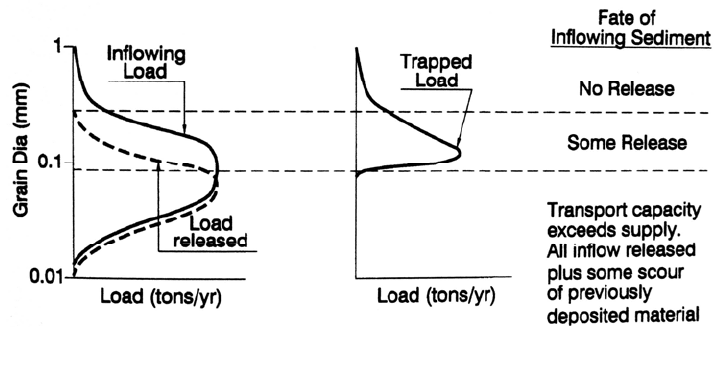
SEDIMENT ROUTING 13.9
FIGURE 13.5 Conceptual diagram showing variation in grain size of inflowing load of sedimen
t
released from an impoundment by sediment pass-through or by flushing.
Sediment balance is achieved when transport capacity through the reservoir matches or
exceeds the inflowing loa
d. For streams in which the rate of sediment transport is supply-
limited (rather than transport-limited), the transport capacity required to successfully pass
sediment through the impounded reach will not be as large as the inflow transport
capacity. If inflowing sediments create a deposit along the length of the reservoir, sedi-
ment movement along the impounded reach may be transport-limited while movement
along the reaches upstream and downstream of the reservoir is supply-limited.
Deposits within the impounded reach may evolve toward an equilibrium condition by
an episodic process. In narrow impoundments, the finer material that is initially deposited
can be partially washed out by a high-discharge event, as described at Rock Creek
Reservoir in Chap. 22. Over time the grain size on the surface will gradually increase. In
an impounded reach wide enough to develop a channel-floodplain configuration, the
channel bed will coarsen while floodplain deposits continue to consist of fine-grained
sediment. The accumulation of coarse material within the scour channel can encourage the
channel to erode adjacent fine-grain deposits, laterally shifting its course.
13.3.3 Sediment Adjustments under Routing
Conversion of a conventionally operated reservoir to a sediment routing operation will
change the sediment deposition pattern within the impoundment. The longitudinal deposit
profile can change both in geometry and grain size distribution as coarser material is
transported to the area of the dam. Existing delta deposits may be mobilized and moved
downstream, and coarse material delivered by the stream plus remobilized delta deposits
may prograde over fines closer to the dam. Depending on the grain size distribution and
other factors, erosion of existing delta deposits may be limited by armoring and coarse bed
material may continue to be trapped.
As a result of flood routing, the sediment discharge downstream of the dam will mimic
but not necessarily match natural conditions. Pass-through causes sediment release below
the dam to be more episodic than inflow. Sediments will accumulate above the dam during
impounding periods and will be released only during infrequent flood routing periods.
The transport of detrital organic material represents a small but ecologically important
component of the sediment in rivers. This organic detritus, which is a source of food and
nutrients to downstream riverine and estuarine ecosystems, may be efficiently trapped dur-
ing the impounding period even in reservoirs which have otherwise achieved a sediment

SEDIMENT ROUTING 13.10
balance. Sediment release during infrequent routing events may deliver short-term pulses
of particulate material to downstream aquatic systems, separated by long periods with
limited export of organic detritus. Organics exported from the reservoir outside of the
routing period can be expected to be quite distinct from the form of detrital material
(leaves, etc.) exported by the watershed. Organic material from the reservoir will already
have been processed by reservoir organisms, and may be replaced with algae and
zooplankton specific to the reservoir environment. Thus, the ecological impact on
downstream food chains may be large, even though a complete sediment balance is
otherwise achieved on an annual basis.
13.3.4 Modeling Considerations
Pass-through operations are analyzed with numerical models simulating long-term patterns
of sediment delivery and transport through the impounded reach. The long-term sediment
release efficiency may be simulated for alternative operating rules which specify both the
extent and duration of drawdown, subject to operational constraints particular to each site.
Numerical modeling can simulate the overall behavior of the reservoir including patterns
of sediment accumulation, evolution of the grain size distribution of the deposits, and the
material discharged from the dam. Armoring can be important, and it may be necessary to
simulate a wide range of grain sizes including both fines and coarse material. Physical
modeling may be required to address questions concerning three-dimensional scour and
deposition phenomena in the immediate vicinity of hydraulic structures such as gates and
intakes, or the effect on river training structures such as dikes. Physical modeling can also
be used to analyze sediment accumulation, evolution of the grain size distribution of the
deposits, and grain size and quantity of sediment discharged under different operating
rules. Examples of modeling are provided in the Feather River and Loiza case studies
(Chaps. 22 and 20, respectively).
13.4 FLOOD DRAWDOWN BY HYDROGRAPH
PREDICTION
13.4.1 Technique
Sediment can be routed through the pool by drawing down the reservoir to a low level
before arrival of a flood, passing the rising limb of the flood through the impounded reach,
and refilling the reservoir with water from the hydrograph recession, which often has a
lower suspended sediment concentration than the rising limb. Between flood events the
reservoir is operated in conventional impounding mode.
13.4.2 Application
When a reservoir pool is lowered, the discharge must necessarily exceed inflow. Early
drawdown is necessary at sites where reservoir level cannot be lowered during a flood
because of limited low-level gate capacity or to avoid increased flood damage downstream
caused by releases which significantly exceed inflow. Early drawdown may be particularly
useful for enhancing the pass-through of suspended sediment, especially where velocities
are too low to remobilize sediment once deposited on the bed.
13.4.3 Operational Sequence
Drawdown for individual floods is feasible in a storage reservoir when the combination of
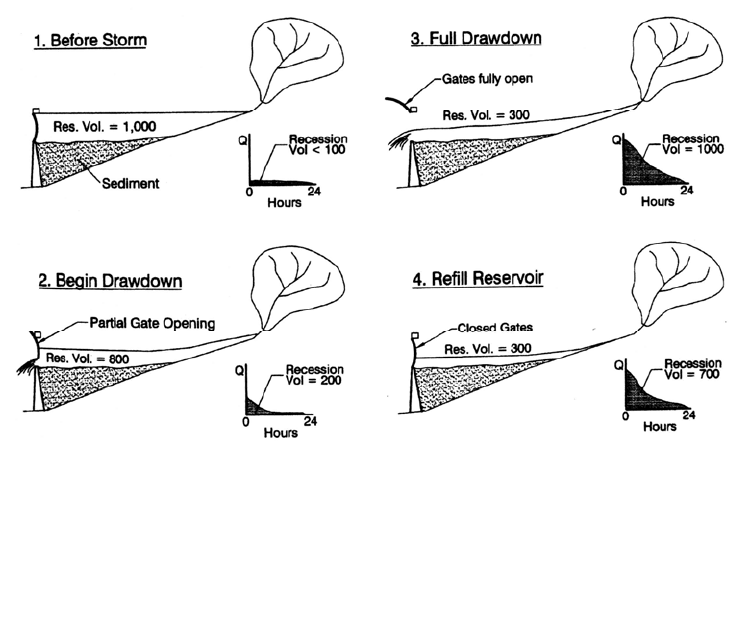
SEDIMENT ROUTING 13.11
flood forecast lead time, reservoir volume, and gate capacity permit drawdown prior to the
arrival of a flood wave. For maximum effectiveness, the reservoir is brought to a minimum
level before the arrival of the flood, all gates remain fully open during the flood, and gates
are closed when the flood recession contains only enough water to refill the reservoir. This
operation requires real-time information on the volume of water tributary to the dam,
consisting of two components: (1) the volume of water in the reservoir and (2) the runoff
volume contained in the flood hydrograph which has not yet reached the reservoir. The
volume in the reservoir can be continuously monitored by reporting level gages at
different points along the impoundment, and the water volume in the hydrograph recession
can be continuously predicted with real-time reporting raingages and hydrologic modeling.
This routing procedure is described below and illustrated in Fig. 13.6.
1. Impounding. Between flood events the reservoir is impounded normally. Weather
forecasts are checked regularly to anticipate meteorological conditions that could
produce high runoff.
2. Lowering. When potentially significant rainfall begins, gate opening is initiated to
lower the pool as far as possible, without allowing the total water volume upstream of
the dam (reservoir storage plus predicted hydrograph volume) to fall below the
reservoir storage capacity. Because releases are made only as rainfall is received in
the watershed, if rainfall tapers off at any point during the drawdown process the gates
are closed and the reservoir is refilled.
3. Full drawdown. Full drawdown is achieved when all gates are fully open, producing
the lowest water level and the highest flow velocity possible at the given discharge.
FIGURE 13.6 Operational sequence to pass suspended sediment through a
hydrologically small reservoir without removing it from service, based on flood
drawdown by hydrograph prediction.
SEDIMENT ROUTING 13.12
4. Refill. The tributary water volume (reservoir storage plus hydrograph volume) is
continuously monitored. When the storm recedes and the tributary volume (reservoir
storage plus watershed hydrograph) declines to a value equal to total reservoir vol-
ume, ates are closed and the reservoir is refilled from the hydrograph recession.
This technique, described in the Loíza case study (Sec. 20.6), has the potential for wide
applicability in hydrologically small reservoirs, including reservoirs rendered hydro-
logically small by sediment accumulation. Advances in instrumentation, telemetry, and
computer modeling technology provide the tools needed to implement an economical real-
time hydrologic forecast system for suspended sediment routing.
13.4.4 Monitoring Reservoir Volume
Because the water surface will slope appreciably during routing, the stage-storage rela-
tionship developed for level pool conditions cannot be used to estimate the volume in the
impounded reach during a flood. The hydraulic gradient will vary along the length of the
impoundment and over the duration of the routing event. To estimate storage volume
while retaining the simplicity of a single-value stage-storage relationship, the reservoir
may be divided into a number of lengthwise segments and a separate level-pool stage-
storage relationship developed for each segment. Each segment might, for example,
represent the volume contained between successive cross-section survey stations. Data
from two or more reporting level gages along the length of the reservoir may be used to
determine the water surface profile, using interpolation to generate the water levels at each
of the intermediate segments for which a stage-storage relationship has been developed.
The total reservoir storage at any point in time is given by the summation of the storages
in each segment. Computational accuracy may be enhanced by increasing the number of
stage-storage segments, increasing the number of level sensors, and developing more
sophisticated algorithms for interpolating the levels measured at discrete points.
13.4.5 Hydrograph Prediction
The essential elements required for hydrograph prediction are antecedent and real-time
hydrologic data (e.g., precipitation and river stage) and calibration datasets. Data on
snowpack, temperature, operation of upstream reservoirs, and other parameters may also
be important. Runoff hydrograph volume may be predicted from upstream river gages or
rainfall data and hydrologic models which incorporate soil moisture accounting and route
runoff from each subcatchment to the reservoir. Examples include the Sacramento model
(Burnash et al., 1973) and the SSARR model and antecedent precipitation index (API)
rainfall-runoff models incorporated in the U.S. National Weather Services River Forecast
System (Page and Smith, 1993). The World Meteorological Organization has reviewed a
number of operational hydrologic models suitable for real-time forecasting (Becker and
Serban, 1990) and has compared the operational capability of 14 models (WMO, 1992).
The following features are important regardless of the model that is used:
Adequately account for antecedent soil moisture and, in temperate climates, snowmelt
(especially rain on snow events).
Automatically adjust for the loss of one or more stations from the gaging network dur-
ing an event due to damage by lightning, wind, flood, etc.
Adjust or recalibrate during a prolonged event on the basis of observed runoff at a
gage station.

SEDIMENT ROUTING 13.13
Range alarms and consistency checks to help detect gages which may continue to
send signals despite erroneous data.
Presentation of results in a format that facilitates operational use.
Calibration should give primary emphasis to predicting total hydrograph volume, and
particularly hydrograph recession at the end of the storm. Because failure to refill the
reservoir can create a critical condition, a safety factor should be incorporated which
ensures there is a low probability that the reservoir will not be refilled completely. The
safety factor should be revised periodically, since model accuracy should increase with
time as data from re-calibration events become available. Operation can also be improved
by use of meteorological forecasts and tools such as weather radar to monitor rainfall
intensity.
13.5 FLOOD DRAWDOWN BY RULE CURVE
13.5.1 Technique
In smaller reservoirs or barrages with large gate capacity, the water level can be lowered
during a flood event to pass sediment, with gate operations guided by a rule curve and
discharge measurements at the dam or an upstream gage station. Lower-level and longer
duration drawdowns will increase sediment transport through the impounded reach and
can also increase the grain size of the material transported. The amount and grain size of
the material mobilized can be controlled by the rule curve. For example, in the small
reservoirs on the Feather River in California described in the case study (Chap. 22),
because of downstream environmental considerations it was desired to stabilize reservoir
capacity but not to flush previously deposited material from the impounded reach. The rule
curve was developed to meet this criteria, although the gate capacity could allow
additional drawdown and flushing of previously deposited material.
13.5.2 Operational Example
The 44-m-tall Cowlitz Falls Dam is a run-of-river hydropower facility equipped with two
Kaplan units capable of discharging 297 m
3
/s. Located on the Cowlitz River about 23 km
downstream of Randle, Washington, the dam was completed in 1994. Its storage capacity
of 12.6 Mm
3
is equivalent to a capacity to inflow (C:I) ratio of only 0.3 percent.
The cofferdam upstream of the dam was left in place after dam construction to deflect
sediment into the sediment bypass channel during routing events and prevent its entry into
the turbines. The sediment bypass terminates at two low-level sluices, each 3.6 x 4.9 m
with upstream-sealing wheel gates. There are four radial crest gates and an emergency
spillway is also provided. The project layout is illustrated in Fig. 13.7.
Sediment transport along 30 km of river plus the impoundment was analyzed using the
HEC-6 sediment transport model with 37 river cross sections. Sediment transport through
the bypass channel and gates was analyzed by physical modeling. Sediment management
is only one of several parameters that will influence the development of a rule curve, and
at Cowlitz Falls four criteria were important:
1. The 100-year flood level in the upstream area of the reservoir cannot exceed the
pre-dam flood level. This established a minimum flood control drawdown curve.
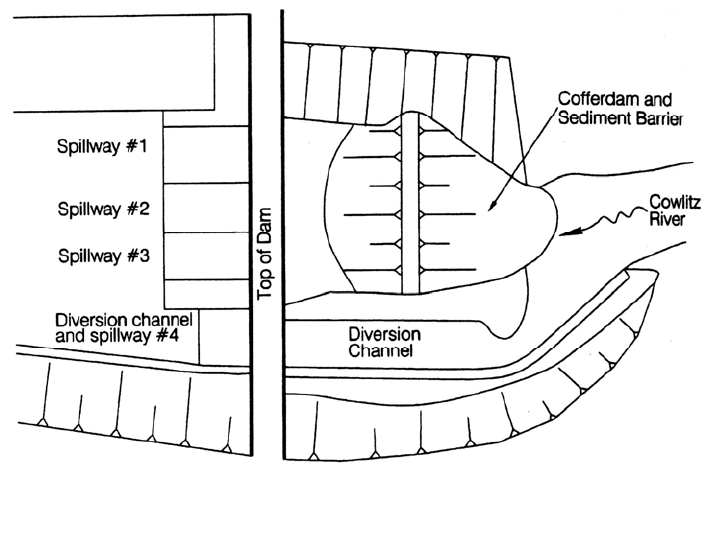
SEDIMENT ROUTING 13.14
FIGURE 13.7 Layout of the Cowlitz Falls Dam showing location of submerged upstrea
m
cofferdam which diverts sediment-laden flow into the diversion channel and low-levels outlets
(after Locher and Wang, 1995).
2.
Prevent sediment deposition in the upstream portion of the pool that would cause
upstream flood levels to increase, and pass as much sediment as possible beyond the
dam.
3. Allow continuous operation of the turbines throughout routing events by maintaining
pool level above the top of the cooling water intake for generating units.
4. Fully open crest gates as early as possible during floods to facilitate the passage of
floating debris.
The rule curve meeting these criteria is presented in Fig. 13.8.
The unusual sawtooth configuration produced by the Cowlitz Falls rule curve results
from the following operational sequence:
1. Normal pool elevation (262 m) is maintained up to 297 m
3
/s with all releases through
the turbines, and between 297 and 652 m
3
/s the turbine release is augmented with
sluicing through the diversion channel and low-level outlet.
2. Between 652 and 765 m
3
/s the reservoir is drawn down in accordance with upstream
flood control criteria by using turbines and sluices.
3. Between 765 and 1190 m
3
/s, the crest gate in spillway 4 is opened as required to
maintain a water surface elevation of 257 m.
4. At 1190 m
3
/s, bay 4 is fully opened. When flow increases to 1615 m
3
/s, bay 1 is also
opened. Bays 2 and 3 are opened when discharge exceeds 2550 m
3
/s.
The longitudinal profile of the river reach upstream of the dam is somewhat unusual,
having an area of very steep gradient near the dam. During drawdown, velocities will
continue to be low in the deep pool area near the dam, which will restrict the grain size
that can be passed through the dam to material not larger than fine sands (Locher and
Wang, 1995).
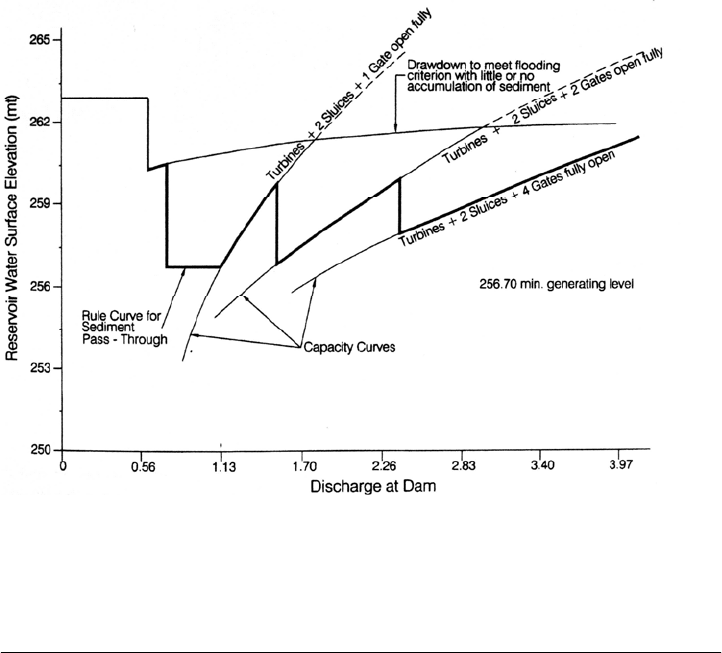
SEDIMENT ROUTING 13.15
Selective withdrawal can improve water quality for a variety of uses. Anaerobic
FIGURE 13.8 Rule curve for sediment pass-through operation at Cowlitz Falls Dam (afte
r
L
ocher and Wang, 1995).
13.6 SEDIMENT BYPASS FOR INSTREAM
RESERVOIRS
13.6.1 Technique
When topographic conditions are favorable, a large-capacity channel or tunnel can be con-
structed to bypass sediment-laden flow around an instream storage reservoir. This
configuration eliminates the need for a large-capacity spillway at the main dam since flood
flow is diverted.
13.6.2 Application
Sediment bypass around an instream impoundment has been reported at the Nagle
Reservoir in South Africa (Annandale, 1987) and is proposed at the Ho-Ku Reservoir in
Taiwan (Hwang, 1985). At the Nagle Reservoir (Fig. 13.9) the storage pool is located in a
river meander and floods are bypassed through a channel across the meander bend. The
flood gates control flow along the flood channel and are normally closed, allowing inflow
to overtop the flood weir and enter the storage pool. During floods, the gates are opened
and the flood weir diverts sediment-laden water into the bypass channel, which
simultaneously flushes sediment from the reach upstream of the flood weir. Located in
shallow water at the upstream end of the reservoir, the flood weir is much smaller than the
main dam. This strategy may be used to bypass both suspended and bed load.
The sediment bypass configuration proposed at Nan-Hwa Reservoir in Taiwan
described by Hwang (undated) is based on a similar concept (Fig. 13.10). In this instance
